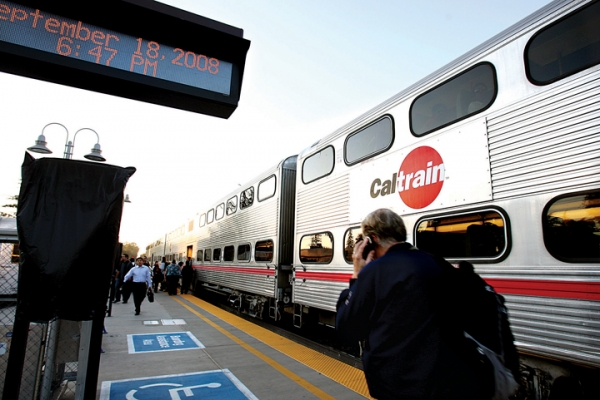With California officials looking toward Central Valley as the launching point for the state's controversial high-speed-rail line, Caltrain is looking for ways in which it can play a central role in accommodating high-speed-train service on the Peninsula.
The cash-strapped system, which subsists largely on donations from the three counties it serves, is preparing to conduct a series of feasibility studies to assess its infrastructure needs and consider improvements that would make it financially sustainable, Caltrain officials announced Monday.
The Peninsula Corridor Joint Powers Board, which oversees Caltrain, has been working with the California High-Speed Rail Authority to bring high-speed rail to the Peninsula, via the Caltrain Corridor. Those plans, however, suffered a setback last year when the rail authority decided to build the first leg of the $44 billion system in Central Valley.
Now, Caltrain officials are lobbying the rail authority for a "phased approach" in which a newly electrified Caltrain would ferry passengers in the first phase of the project. This approach would allow high-speed-train operations in the Peninsula without requiring the construction of a new rail system in the Caltrain Corridor. The request is also consistent with the position of three Peninsula legislators -- U.S. Congresswoman Anna Eshoo (D-Palo Alto), state Sen. Joe Simitian (D-Palo Alto) and state Assemblyman Rich Gordon (D-Menlo Park) -- who are calling for a "blended" system of Caltrain and high-speed rail.
"In a phased approach, the first phase is envisioned to electrify the Caltrain system and potentially allow CHSRA to operate enough service to satisfy initial ridership demand," Caltrain announced in a statement. "Subsequent phases would expand the capacity of the system to meet additional ridership demand if needed."
Caltrain officials said the new studies would include ridership projections, service plans, cost estimates and impact analysis. The new analysis, they said in a statement, "marks the first time Caltrain has undertaken an independent assessment of the commuter rail agency's infrastructure needs in a manner that focuses on the possible additional elements that could be necessary to operate an initial level of high-speed rail service in the future on the Caltrain right-of-way."
Caltrain officials project that electrifying the system and adding other improvement such as a new signaling system and new trains, would reduce the agency's operating deficit by 45 percent by 2019 and reduce emissions by about 90 percent. On Monday, Eshoo, Simitian and Gordon spoke in favor of Caltrain's "modernization" project" and argued that it should be part of the state's vision for "high-speed rail done right."
Eshoo said Monday that "there's no need to duplicate" Caltrain's service by building a new rail system on the Peninsula and pointed out that the dollars for a new transit system are currently scarce.
"I'd rather see something where we invest $1 billion to upgrade Caltrain and blend it with what may come up from Central Valley," Eshoo said.



Comments
Downtown North
on Apr 18, 2011 at 5:04 pm
on Apr 18, 2011 at 5:04 pm
Kudos to Simitian, Eshoo, Gordon, Caltrain, and "potentially" CHSRA, for working together and trying to create a solution that does not destroy our neighborhoods.
Finally, some common sense in the game.
Another Palo Alto neighborhood
on Apr 18, 2011 at 7:34 pm
on Apr 18, 2011 at 7:34 pm
Caltrain is an almost non-existent organization. It's board is made up of amateurs, and the system has absolutely no experience in running a system profitably. The idea that it can take on HSR is ludicrous.
Time for Simitian to take "the long walk". He's been talking to his labor union friends just too darn long.
Registered user
Midtown
on Apr 19, 2011 at 9:25 am
Registered user
on Apr 19, 2011 at 9:25 am
Simitian finally got one right. While no one can predict what will run on the tracks between Gilroy and Frisco, I would rather have electrified, separated Caltrain sooner and 250 mph to LA later.
Downtown North
on Apr 20, 2011 at 4:23 pm
on Apr 20, 2011 at 4:23 pm
I appreciate the sentiments from this week's press conference, but I will be watching to see how some apparent contradictions are addresses. Every speaker talked about NOT having an "aerial viaduct" on the Peninsula, but I don't think you can run trains at 150 mph or more on tracks that have ground-level street crossings ("grade crossings")... and the only alternative to a grade crossing is a bridge (which seems like an aerial viaduct to me), a tunnel (already rejected for cost reasons, as I understand it), or just closing some of the streets that currently cross the tracks.
I also don't understand the insistence that a "blended" Caltrain/high-speed system can move trains from San Jose to SF as quickly as one with dedicated high-speed tracks.
So... it all sounds great, but the devil will be in the details. Please let's get on with it - we definitely need both a stable, fast Caltrain system and California high-speed rail.